At breakfast this morning, Jim put our juice down at a table with one other cup, assuming it belonged to another person in our group. When the cup owner showed up shocked that 3 people had stolen his table, he prepared to move but I invited him to stay and join us. It turns out he is a pilgrim from Montreal, and on the second year of a multi-year trek to Santiago del Campestola, the end of the Camino. I wasn't clear where he started, but his total distance is upwards of 950 miles. He walks for about 3 weeks at a leisurely pace, covering up to 15 miles in a day.
At 8am, Nico outfitted us each with a red scarf like those used on the Run with the Bulls, and walked us through the route, highlighting a section of fence left in place for demonstrations, a sharp turn where the bulls hooves may slip on the cobbles, and the narrow entry to the bull ring. When you sign up for the run, you are not allowed to back out. If runners try to escape the route during the run, they are normally shoved back into the fray by the observers. The best place to run is along side the bull, with your hand touching its back. Everyone who runs through the first of two bull ring doors gets in for free.The door is closed promptly when the last bull enters and the slowpokes all pay if they want to see the bull fight. There are 5 days of runs and they even have a 'kiddie' run for those under 18 with bulls that are too young to have horns. We also saw a wonderful statue depicting the race.
 |
Two sections of fence. There are covered post holes in the
street that are larger than the post so they are made secure
with huge shims at the base. |
 |
| Nico, Jim, and Don getting ready to watch (or run). |
 |
| There were several adorable cartoons like this on the route. |
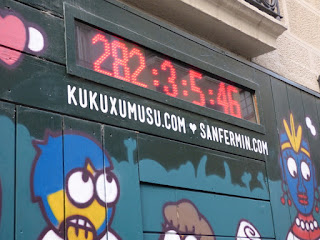 |
| The clock is counting down to the next run |
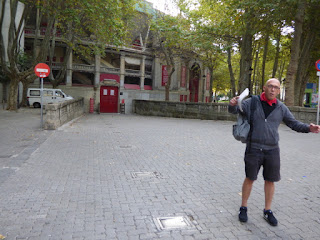 |
That red door in the back is the first door to the bull ring. The
metal plate to the left of Nico is a post hole, and they funnel
down to the gate. |
 |
| The first of 4 photos showing the bull run sculpture. |
 |
| The figure lying on the left is a self-portrait of the artist. |
 |
| Warning sign |
Then we stopped for coffee and tea. On the way back to the hotel, Jim wanted a pastry, so we ducked into a tiny shop and he spied the eclairs and wanted to split one. I didn't think my Spanish was so bad that they would have trouble figuring out 'una eclair' with the associated pointing, but they looked at us blankly. A lady sitting just behind us at a petite counter reading her paper and enjoying her coffee joined in with very good English and helped us out, ordering in Basque. We spoke for a bit and learned that she had spent a month with friends in Orinda, a community on the east side of the Bay Area!
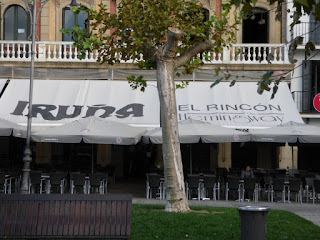 |
| Our coffee shop next to the Hemingway place |
We regrouped at the hotel and headed out past Roncevalles, north near the French border, to walk a few miles on the Camino, stopping for lunch about halfway. It was supposed to be sunny and mid 60s with no chance of rain. Apparently the forecasters here are no better than the terrible ones where we live because it was more like mid 50s, misty, and breezy. Lucky for me, most of the walk was through a wooded trail which blocked both wind and misty, but my very light fleece jacket was not quite up to its task. The only solution was to walk fast to warm up.
 |
| We walked up to this marker to start. |
 |
| View from the top |
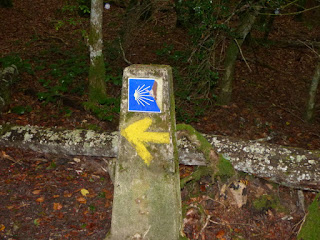 |
| Sign to show the way |
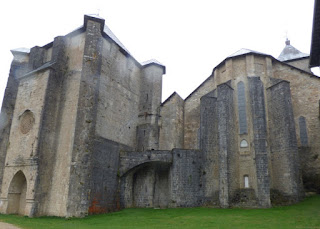 |
Church in Roncevalles with buttresses that are not the
flying kind. |
We collected a stamp at a waystation in Roncevalles where lunch was, but apparently were too fast as we had 45 minutes before the lunchroom opened. They finally took pity on us standing inside to be warm and dry and clogging up their bar, and opened the dining room and brought wine, a big basket of bread, and a plate of pancetta for each group of 4. All the portions were quite large. Next up was a salad with shrimp and what looked like short white and black noodles -- which looked to me suspiciously like the fake baby eel delicacy I had read about. The real eels are the delicacy, angula in Basque, and look like 2 inch long skinny worms with recognizable eyes and mouth. Unfortunately, the river pollution killed most of them, and now 'gula' are more common, a fake eel made from surimi, which is any random fish and filler you can find. They are immediately identifiable because they have no eyes or mouths, tho apparently some come with 'eyes' now. They are also not nearly so tasty. I thought the salad was fine, but avoided the 'noodles' which were confirmed to be gula, as suspected. Because we had more walking to do, and it was a big salad, I assumed that was the end. WRONG! The next course was a plate of sausages, which I tried one of. Then there was a bowl of something less soupy than a boullebase, which I skipped. I thought for sure we were done then and I was full. But no. next up was a thick pork loin, french fries, and roasted peppers. And then dessert -- an apple galette, a coffee flan, and Basque profitteroles served with a side of whipped cream drizzled with chocolate.
Adding to the enjoyment of lunch was the interaction between folks at our table and several others. A Chinese-looking man came in with a Cleveland Indians hat and posed for our Cleveland couple. We shared some of our overflow with other tables and got partial bottles of wine in return as we had finished off the 3 we were allotted. We also got some rose wine from a French pair, who had been talking to our French guide, Nico. Several folks had vests that identified them as the hospitality group (hostel help) and one waggled a bunch of keys -- he is Dutch and volunteers along the Camino. In all, a really warm and cheery group of diverse people.
Back on the trail, we had another 1.5km to the bus. I was chilly so we power walked and got to the warm, dry bus first. Then it was back to Pamplona for free time til dinner.
After dinner, we went for a short walk along the old walls. Since the sun goes down at 8pm or so here, photography was a challenge, but some worked out. Tonight we pack and head to Leon.
 |
| The wheels were used to operate the drawbridge. |
 |
| Bridge |